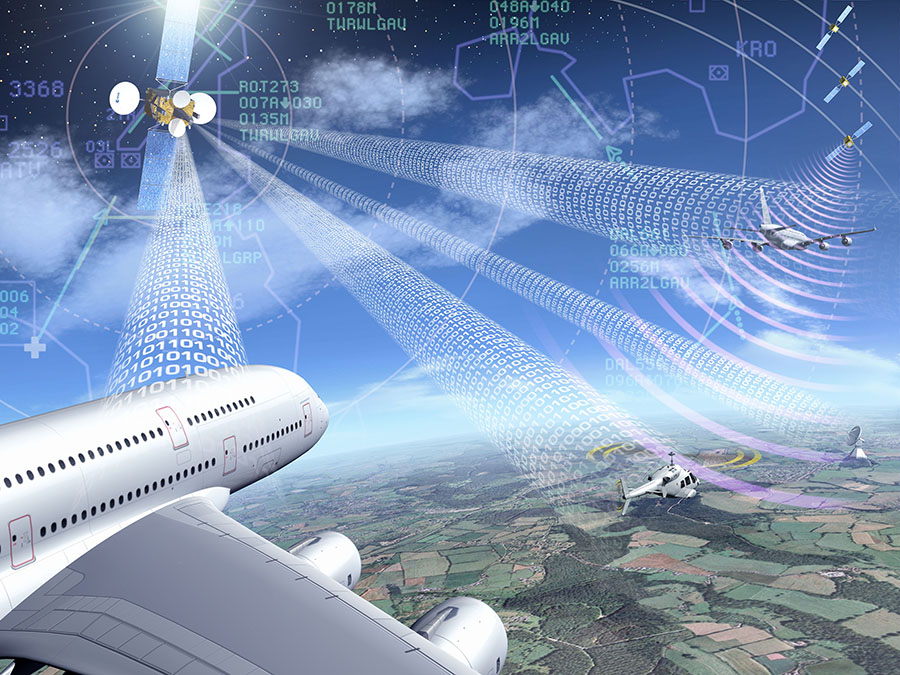
Simona Pierattelli, Leonardo, is coordinator of I-CNSS, a SESAR research and innovation project dedicated to developing an integrated communications, navigation and surveillance (CNS) infrastructure for Europe. In this Q&A, she explains how CNS technologies can support to make air and ground operations, including airports, more efficient, while also ensuring global interoperability from an avionics and satellite systems perspective.
Why do we need to address the current communications, navigation and surveillance infrastructure?
European air traffic management makes use of a patchwork of CNS infrastructures with different technologies and networks, which is costly and inefficient. Added to that, traditionally the communications, navigation and surveillance (CNS) domains within each of these infrastructures have been kept separate so one domain could back up another at an operational level. What we see is that this legacy structure fails to take advantage of cross-domain synergies between technologies and space-based solutions enabled by the global navigation satellite system (GNSS).
What is SESAR proposing?
We are working on a more integrated and spectrum efficient CNS concept that takes advantage of ground and satellite-based systems, and advances in digital technology. The aim is to move away from an infrastructure where systems and technologies are prescribed to a performance-based approach, based on the operational requirements and considering CNS as an integrated system. By deploying new CNS systems and rationalising legacy ones, we believe that we can make aviation smarter and more efficient and meet the ambitious performance goals of the European ATM Master Plan.
What are the main objectives of the project that you are leading?
The project aims to develop an integrated suite of CNS solutions meeting the current and future operational requirements of air traffic management in the short, medium and long term. This includes a strengthened security and increased spectrum efficiency. In addition, it aims to ensure their global interoperability, as outlined in the ICAO Global Air Navigation Plan (GANP).
The PJ14-W2 I-CNSS project aims to support European and global harmonisation of CNS between airlines, air navigation service providers (ANSPs) and industry, in addition to interoperability between the civil and military aviation.
What are the main technologies you are working on?
PJ14-W2 I-CNSS is working on a suite of CNS solutions:
Communications bringing together Terrestrial, Satellite and Aerodrome technologies:
- A network infrastructure based on “multilink” supporting both legacy data links and modern network digital technologies;
- A high capacity ground-based line-of-sight data link LDACS;
- The evolution of satellite-based COM system SATCOM ATN/OSI into ATN/IPS;
- Hyper connected ATM , a new solution to use public air-ground links for transferring datalink messages, as a complement to dedicated safety links;
- SWIM TI purple profile for air/ground safety critical information sharing;
- SWIM TI green profile for Ground/ground civil-military information sharing.
Navigation incorporating GNSS technologies and alternatives for robust new systems:
- Highly resilient runway independent GNSS landing systems for low visibility cat II/III using ground based augmentation (GBAS) with multiple satellite constellations including GALILEO, and multiple frequencies, also applicable by complex airports and at extended latitudes;
- Innovative solutions for alternative positioning, navigation and timing system including LDACS (NAV), Multi-DME, Enhanced DME and Terrain Vision in support of more demanding RNP operations;
- Using the aircraft as an AIM/MET sensor and consumer.
Surveillance to monitor both Space Based and Ground Based systems
- Multi-sensor data fusion;
- Future ADS-B communication link, based on phase overlay transmission, to resolve congestion on the safety critical 1090 MHz frequency;
- Multi-tower remote surveillance, including integration of camera surveillance;
- Secured surveillance systems;
- End-to-end surveillance performance monitoring tools.
What are the expected benefits? Who stands to benefit?
The main benefits of performance-based CNS concept implementation are:
- Increased and future proof technical performance for airspace users and operational environment needs while ensuring resilience and contingency.
- Improved spectrum efficiency, knowing that spectrum is an extremely scarce and expensive resource
- Support innovation in terms of performance, virtualisation and security aspects
- Enabled synergies across CNS domains.
- Reduced annual operating costs and investment budgets
Who is involved in the project?
Coordinated by Leonardo, the project brings together 17 beneficiaries from different European countries including industries and ANSPs. It is funded within the framework of the European Union’s Horizon 2020 research and innovation programme under grant agreement No 874478.

